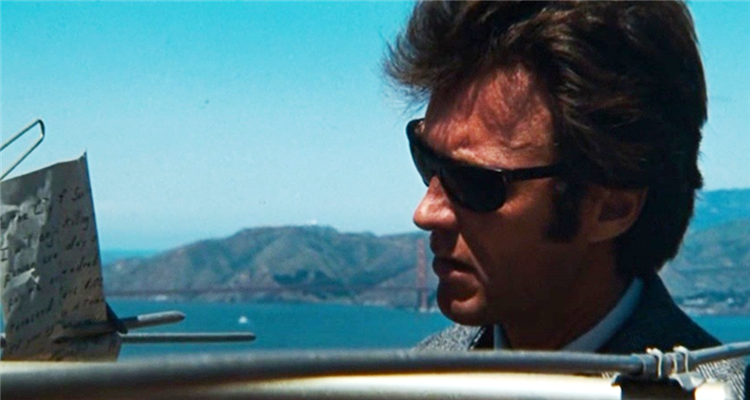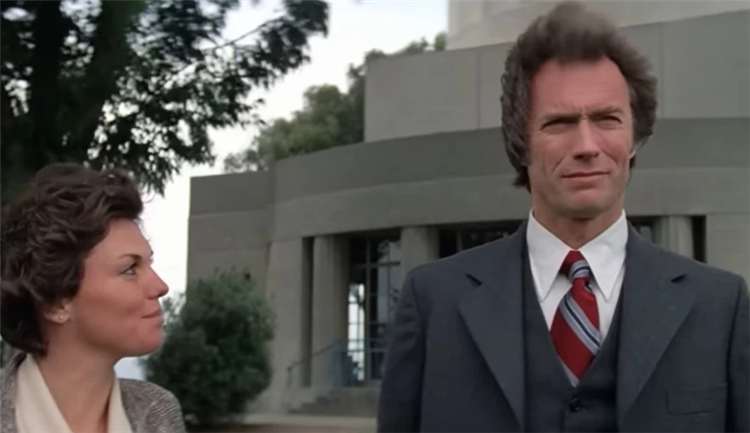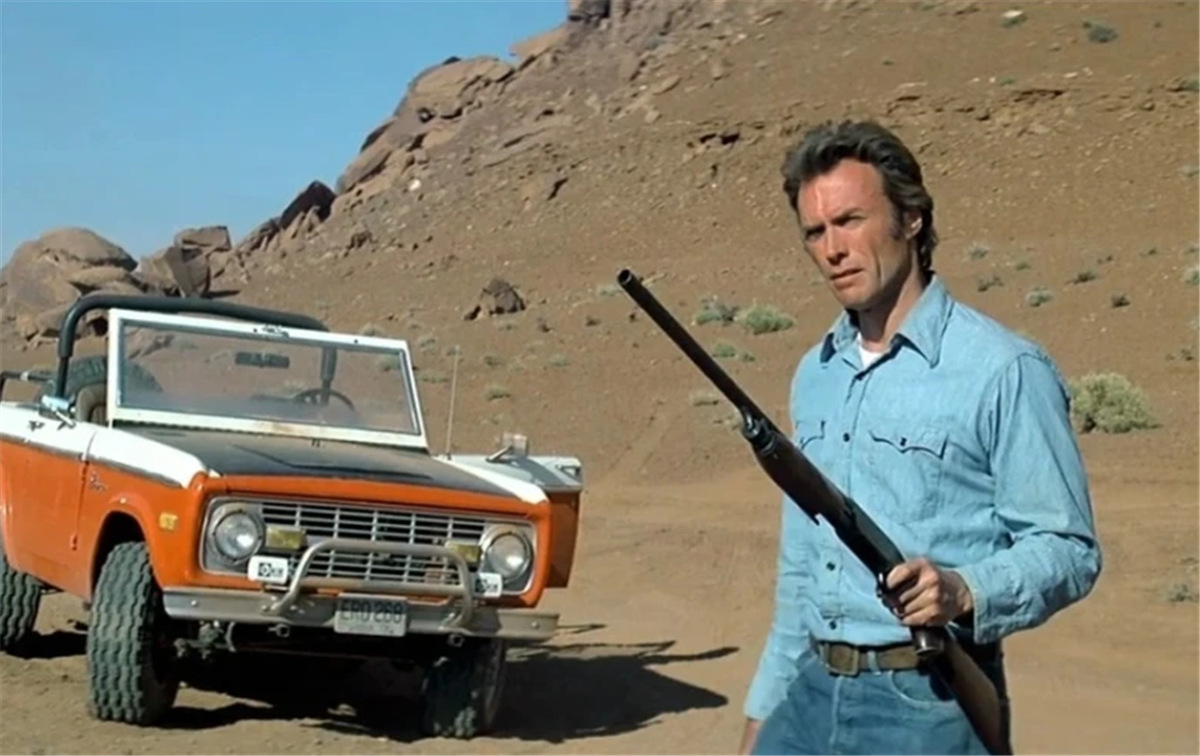The Gauntlet(1977), directed by and starring Clint Eastwood and co-starring Sondra Locke, was an attempt by Clint to send up his ‘Dirty Harry’ films by exaggerating and parodying the tropes associated with those cop thrillers.
Originally conceived as a starring vehicle for Marlon Brando and Barbara Streisand, and then, after Brando’s withdrawal, as a vehicle for Steve McQueen and Streisand, Warner Bros’ action thriller, “The Gauntlet (1977),” that ended up starring Clint Eastwood and Sondra Locke, and being directed by Clint himself, is, at once, a typical ’70s\’80s Clint Eastwood blood & guts cop actioner (as the Frank Frazetta designed official poster of the film promises) as well as one of the oddest films in Clint’s filmography. Of course, any film which has Clint stepping into Brando’s shoes might be odd, what with both actors being as different from each other as chalk is from cheese: one famed for playing losers and the other always the all-conquering hero. But more than this obvious oddness, this film finds Clint trying to take his “Dirty Harry” persona in an interesting (and even weird) direction. The plot of the film seems rather conventional enough, and seems to be taken from classic crime\Noir films of yore like “Narrow Margin”: a lawman has to escort an important female witness, who can testify against the mob, from a remote location to the city; on the way, the cop has to fight off the mob’s henchmen, who are determined to kill the witness, as well as corrupt officers in his own department. But where “The Gauntlet” drastically differs from those crime dramas is in the subversive tactics employed by the writers in the characterization of the two lead protagonists; as well as an exaggerated, absurdist tone maintained by director Clint throughout the film, especially in the treatment of the many violent action sequences in the film. The action\violence in the film is amplified to the point that it becomes absurd and humorous; pretty much like the ultra-violent, baroque action films that Dutch director Paul Verhoeven (Robocop, Total Recall) used to make in the ’80s\’90s.
The plot of the film goes something like this: In Phoenix, Arizona, honest, hard-working, but alcoholic and slow-witted cop Ben Shockley (Clint Eastwood) is ordered by Commissioner Blakelock (William Prince) to travel to Las Vegas and bring back a ‘nothing witness for a nothing trial.’ But from the moment Shockley takes hold of the witness, Gus Malley (Sondra Locke), he finds himself under attack, not only from the mob but also from the cops. Looks like Shockley was misled regarding the importance of the witness. As it turns out, Malley’s testimony could implicate a major police figure in a sleaze & corruption scandal. It doesn’t take long for Shockley to realize that the powerful man in question is none other than his boss Commissioner Blakelock; Blakelock had specifically chosen Shockley because he knew the cop was no good, and he will never be able to bring Malley back. But Shockley is determined to prove his boss wrong by getting Malley back to Phoenix, despite the fact that Blakelock has gauntleted the city with every cop on the force- the cops have been ordered to gun Shockley & Malley down the minute they enter the city. Shockley hijacks a bus and, welding thick steel plates, transforms it into an armored-car. And, In a near-suicidal move, he rides the bus through the gauntlet amidst blazing gunfire and manages to reach the city hall with Malley in tow. In the end, Shockley is successful in delivering his witness and unmasking the corrupt city officials, thus proving his worth.

In 1968, Clint teamed up with Director, Don Siegel, for the first time in his career to make the modern Western\cop drama, “Coogan’s Bluff.” As I mentioned in my review of that film, it was the first step in transforming Clint from a Western hero into a modern action hero. That film had Clint playing an Arizonan cop who goes to New York to bring back a dreaded criminal; Clint fumbles the job and spends the rest of the film trying to hunt down the villain vigilante style. This vigilante cop act will be perfected in the Don Siegel directed 1971 Policier, “Dirty Harry“- the success of that film would turn Clint into a superstar. “The Gauntlet” plays out like a subversive take, or even a serious (and not the broad, fourth-wall breaking kind) send-up of both “Coogan’s Bluff” and “Dirty Harry.” Like Coogan, Shockley is send on an out-of-town assignment to bring back someone, but it’s a woman not a man – the first joke in the film is regarding this gender switch, because Shockley, unlike Coogan or Harry Callahan, is a slow-witted simpleton, who thinks that Gus Malley is a man. Also, the geography of this film reverses the one in Coogan; “Coogan’s Bluff” starts out in an arid Western setting and then moves into the modern big city environment; here, the film starts out in the big city and then moves into the desert landscape of the west. Instead of Clint riding horses, we have him ride bikes and cars. And then, keeping in with the exaggerated nature of the film and as as a send-up of the “Dirty Harry” climax where Clint jumps onto a moving bus, here we have Clint riding a bus in the noisy, destructive climax. The final ten minutes stretch of the film pushes credibility to the extreme, and even falls right over. One of the chief criticism levelled against the film by film critics upon its release was regarding its unbelievable plot and the even more incredible nature of the violence. But that is really the point of this film, Clint is actually having great fun in sending up a major trope of these action thrillers. By staging one of the most baroque action sequences in movie history, where we see the whole Phoenix PD firing at Clint’s bus and failing to stop it from reaching the city Hall, Clint is making fun of the long established convention of how a hero escapes unharmed no matter how many men fire at him. We also see that nobody cares to blow out the tires of the bus and bring it to a stop. it’s like what people said about the climax of John Ford’s “Stagecoach,” where the only thing the Apaches chasing the stagecoach needs to do was to shoot down the horses pulling the coach, but if they did, then one of the greatest action sequences in cinema would have never existed. After watching the climax of this film, Don Siegel had asked Clint to add an additional shot of police officers lying dead on both sides of the street having accidentally shot each other while shooting at the bus- that would have made the satirical nature of the scene more clear, but Clint was not amused by that suggestion and thought it would be too explicit.
By 1977, Clint Eastwood had become so secure in his stardom, and so confident in his abilities as a performer & director that he started to send up his iconic macho action\Western hero persona. “The Gauntlet (1977)” was basically the start of this, and this would be quickly followed by other movies like “Every which way but loose” series and “Bronco Billy.” Even several of his ’80s movies like “Heartbreak Ridge,” “Pink Cadillac” and even the last Dirty Harry film, “Dead Pool” was an attempt in this direction. At the time of making “The Gauntlet,” Clint was unquestionably the biggest movie star in the world; for more than a decade, he had starred in some of the most successful films, including such trendsetting works as Sergio Leone’s ‘Dollars’ western trilogy and the three ‘Dirty Harry’ films. And, with the well-received 1971 romantic thriller, “Play Misty for Me,” Clint had also successfully turned director. In fact, he was just coming off directing the great Western, “Outlaw Josie Wales (1976),” which was one of the best movies he has ever made. Naturally, he was confident enough to take himself into a different direction as a star\actor and director. By this time, he must have sensed that he had taken this all-conquering, anti-authoritarian gunslinger persona to its extreme, and the only way forward for this character is to have some fun with it. This was not the first time Clint had tried this strategy with one of his iconic screen personas- he had already done it to a degree in “High Plains Drifter,” a dark, but tongue-in-cheek take on his “Man with no Name.” Also, his third ‘Dirty Harry’ film, “The Enforcer” was the most lighthearted of all the ‘Dirty Harry’ movies, with Clint’s supercop paired with a lady cop. So, “The Gauntlet,” which once again finds Clint teamed up with a feisty female, who is in many ways superior to Clint’s rather dumb, mediocre cop, was a logical extension of this.

Of course, having the female being more resourceful and intelligent than the hero in this sort of film, and especially in a Clint Eastwood film is a major subversion of the formula. Though Clint’s films are generally perceived to be testosterone-laden, masculine fantasies, one thing that’s overlooked is that his films more often than not have strong female characters. Whether it’s “The Beguiled,” “Two Mules for Sister Sara” or “Play Misty for Me,” his films have provided interesting roles for actresses like Jessica Walter and Shirley McLane. Locke’s Augustina ‘Gus’ Malley is another one of those very interesting female characters. She is a prostitute, but she is intelligent, feisty, and has a college degree- something very uncommon for a movie hooker. Also, Locke is in top form throughout the film; this is, perhaps, the best performance she ever gave; i have found her a very annoying presence in many of Clint’s films, but here she has a genuine chemistry going with Clint, maybe because this was the blossoming stage of their real-life romance. The verbal back and forth between Locke and Clint is crisp and very entertaining, and the scene where she shuts up a foulmouthed, arrogant cop with her sexually explicit talk is her best moment in the film. “The Gauntlet” is the second of the six films that Clint made with Locke, and they were an on and off couple for almost 15 years (both, on screen and off-screen).
As for Clint, the character of Ben Shockley is a departure from his regular Western\action roles. The role allows him to be vulnerable, stupid, romantic, funny and ultimately heroic. You can see why Brando was the original choice for this role, because Shockley is basically a drunk and a loser, a character part that Brando would have been perfect for. Even though the role has been altered to suit Clint – he is now an underdog who triumphs at the end in typical Clint fashion – it still has some of those less than heroic character traits. Right from the opening scene, where we see a drunk Shockley staggering out of his car – the whiskey bottle in his lap hitting the street and shattering into pieces – we know this a very different Clint Eastwood character. Shockley is very much an anti-Dirty Harry: he’s submissive to his superiors, and always do what he’s told. He once had great hopes of becoming a hot shot cop, but upon realizing that he will never be good enough, or he will never get those glamorous assignments, he has resigned himself to going through the motions of police work as impassively as possible. The scene were Shockley, drink in hand, pours out all his regrets to Locke is one of the best and most touching scenes Clint has ever performed.
Clint always had a nice touch with wry, subtle humor and it’s put to good effect here. Most of the times, the humor is situational, emanating mainly from the gullible Shockley finding himself in very outlandish situations. The scene where Shockley, with just his gun in his hand, talks an entire motorcycle gang into surrendering one of their bikes is one of the film’s funniest sequences. Of course, there is a dark payoff to this scene, when, later, Shockley and Malley runs into the same gang, and Malley is almost raped by them. But, true to the film’s exaggerated tone, we find Shockley turning hero, by breaking his shackles and beating up the entire gang. As i already said, this exaggerated tone is maintained in all the film’s major action sequences, with excess violence becoming a metaphor for absurdity. The scene where Shockley and Malley are fired upon by the Las Vegas PD, ends with Malley’s apartment crumbling to pieces. A bike & helicopter chase through the desert, where a sniper takes repeated aim and fails to hit either Shockley or Malley ending with the helicopter exploding, is the most exciting action scene in the film, perhaps, one of the best Clint has ever choreographed; and it’s dizzyingly staged, with swooping camera moves and quick-fire editing, intercutting shots from multiple camera angles, All this perfectly builds up to the absurdist and farfetched climax sequence, which ends with Shockley and Malley shooting down Blakelock, while the entire police department looks on, and walks away alive. This absurd denouement works due to the over-the-top tone that Clint had maintained up until now. This is not a realistic movie by any stretch, though the performances of the lead actors are pretty realistic; and Clint & the writers even manages a fair bit of realism in their characterization as well. This combination of realistic lead performances surrounded by an exaggerated tone can be a little confusing in truly assessing this film, and it confused the film critics of the time as well. Eventually, with “The Gauntlet,” I believe that Clint was actually making fun of the noisy, ultra-violent, preposterous cop\action movies that was made dime a dozen at the time; the same type\genre of film that was, ironically, instrumental in propelling him to superstardom.
